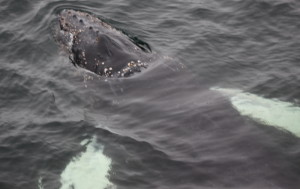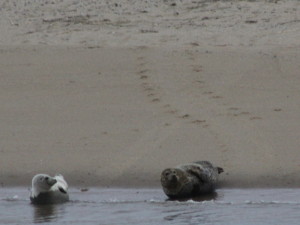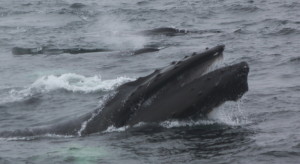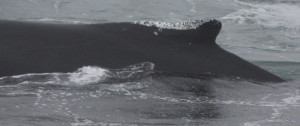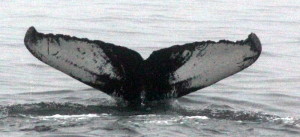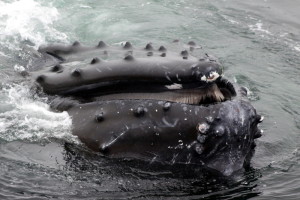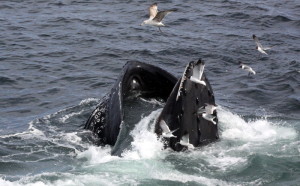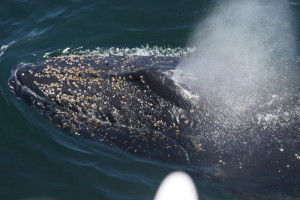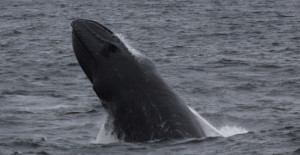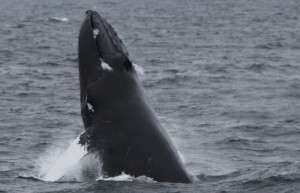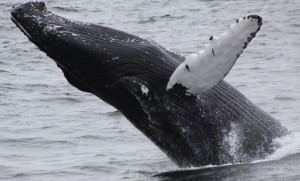Naturalist Notebook – May 3 to May 8
On May 3rd we headed up to the Southwest corner of Stellwagen Bank and found ourselves in the middle of a huge humpback whale feeding bout! At least 20 humpback whales, including Dome, Cajun, Alphorn and Rapier were engaged in a whole repertoire of feeding behaviors, including bubble feeding, kick-feeding, and dragging, all of which help to capture the millions of small schooling fish that make of these whales’ diets.
Dome
The massive amounts of feeding we’ve been seeing on Stellwagen Bank have coincided with a recent important discovery on how baleen whales coordinate feeding. For years, we’ve observed with wonderment how our rorqual baleen whales, including humpbacks, fin whales and Minkes can balloon to almost twice their size as they engulf mass quantities of prey. Recently, scientists reporting in the journal, Nature, describe the discovery of a sensory organ located on the chin of rorqual whales that they believe help to coordinate this feeding motion. They believe that it may send information of prey density to the whales’ brain in order to help the animal lunge, expand its ventral pleats, and swallow its prey. For more information, see this great post in Science Daily.
On May 4th, we spent a better part of the morning trying to figure out the identity of a new humpback mother/calf pair that had appeared on Stellwagen Bank. The mom wouldn’t lift her tail on dives, and so it was very difficult to figure out who she was, as we identify humpbacks by the unique patterns on the ventral side of their flukes. Finally, we got lucky and we discovered that this was a whale named Thumper. Thumper was named for the rabbit track markings on the underside of her fluke. She is 14 years old this year, and this is her second calf. Her calf was extremely energetic and wowed the Dolphin VIII by breaching over and over again!
Thumper’s calf
The morning’s trip was also characterized by roving bands of humpback whales foraging for fish. Their long dives and erratic surfacings of the morning trip turned into a swirling mass of feeding humpbacks in the afternoon. Huge bubble nets drove schools of sand lance to the surface, and they were seen churning and leaping, trying to escape the gaping mouths of the hungry humpback whales.
Meanwhile, on the Dolphin VIII, we were spotting marine mammals as soon as we left the harbor and rounded Long Point. On long point, we had a great view of a young harbor seal pup and its mother hauled out on the beach. After snapping a few photos, we were surprised to see a fin whale just beyond the tip of the point. Fin whales are elusive and can often dive for long periods of time. We waited 15 minutes for this surface but only got one quick look before moving on.
Fortunately, we saw spouts beyond Race Point so we headed north. Upon arrival, we waited several minutes, but there were no whales to be seen. Finally, a calf surfaced. It was Thumper and calf. The calf approached the boat and we got great views of its barnacled head.
We moved even farther to the north and saw spouts all around the southwest corner of Stellwagen Bank. This is often a hot spot for humpback whale feeding, in part due to the steep slope of the bank which interacts with currents to push nutrients to the water’s surface. Despite the driving rain, we had incredible views of group feeding. At one point, between 7 and 10 whales surfaced through a bubble net, mouths agape.
We all got soaked, but there were so many whales everyone forgot about the rain!
May 5th was a foggy morning, but it soon lifted and the waters became still and beautiful. The humpbacks were still feeding away, and their bubble nets attracted a slew of birds, gathering at the surface to scoop up the fish driven to the surface by the humpbacks. One of our naturalists spotted her first Manx shearwater of the year. This little bird is highly migratory, heading to the coasts of South America during the winter. They tend to show up in Stellwagen Bank just after the humpbacks do.
In addition to our exciting seabird sighting, The Dolphin VIII had a visit from a terrestrial songbird, what we think was a black-throated green warbler. Sometimes after windy weather, terrestrial birds get blown offshore and take a break on the rails of our boats before heading home.
We remarked on how clean and distinct the bubble rings and smiled with recognition as we watched one of our most familiar whales surface through the feeding frenzy. It was Salt! Salt’s distinct white dorsal fin makes her easy to identify.
Putter, Springboard, Jabiru, Xylem and Wizard were also seen feeding. The whales were in small groups and the group compositions changed quickly. This ephemeral nature of feeding groups is typical of humpback whales, so we weren’t surprised to see associations change over the course of the trip.
Scylla’s 2008 calf took a break from feeding had did a quick close boat approach, lifting its knobby head out of the water to peer at passengers aboard the Dolphin IX.
On our way back in from Stellwagen, we even got a chance to see a little gang of Harbor porpoise hanging out near the entrance to the harbor. These porpoises often travel alone or in small groups. They are easy to miss, but we spotted their bobbing dorsal fins and were able to get a close look!
Both trips on May 6th featured intense humpback whale feeding in the Southwest corner of Stellwagen Bank with lots of appearances from old friends. Lavaliere, Pogo, Fracture, Division and Bounce all made appearances.
As they lunged through the huge schools of fish, the humpbacks would lift their heads almost completely out of the water, almost as if they were spy-hopping. As they closed their mouths, huge streams of water would drain out the sides, and we could see the muscular pleats on the undersides of their body contracting and squeezing their prey down their gullets.
At one point, Circus, a seven-year-old humpback whale, took a break from the feeding and rolled around on its side, slapping its enormous flipper. Overall, we estimated that at least 25 individuals were spotted today!
On May 7th we seemed to experience the entire repertoire of humpback whale activity up on the Southwest corner of Stellwagen Bank. We couldn’t believe our luck to find that the feeding had continued and we had at least 20 adult humpbacks feeding and foraging in the area. At one point on the morning trip, four humpbacks were chin breaching, and then started to simultaneously flipper as we got closer. While we don’t have a concrete explanation for either of these behaviors, they sometimes appear to have a social function.
In the afternoon, we found a total of 6 mother and calf humpback whale pairs: Thumper, Pisces, Binary, Abrasion, Rapier and Dome were all accompanied by their respective calves. These calves were born over the winter in the Caribbean and will stay with their mothers for about a year, feeding on their mothers milk and learning to feed on fish and krill before venturing out on their own.
May 8th was gray and overcast with an occasional drizzle, and the seas crested at 2-3 feet as we headed out to the Southwest corner of Stellwagen. As we approached, we began to see spouts far to the north, the west, and even a few to the east. We saw some birds, but no visible surface feeding, and we soon determined that the humpbacks were on the move. We saw very few flukes, but fortunately we saw several breaches. Pisces and calf were continually breaching. Pisces chin breached as she traveled north, while her little calf tail breached and even performed a few full spinning breaches!
Soon, the wind picked up to over 20 knots and we slogged our way back to Ptown in 5-6 foot seas! Those of us still brave enough for the upper deck on the way back were treated to a look at several diving gannets, and even a razorbill. Razorbills are related to puffins and are not seen often on our trips!








